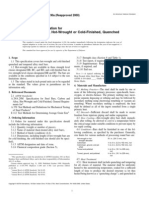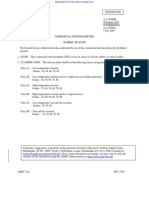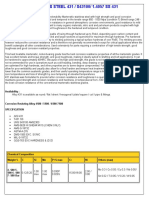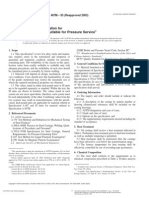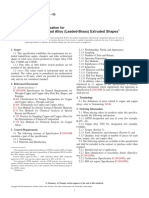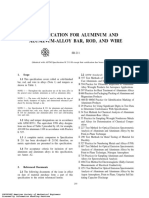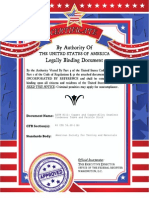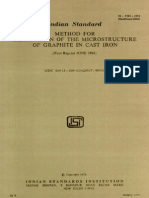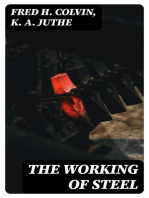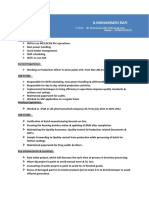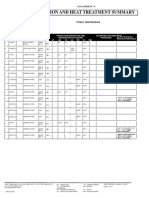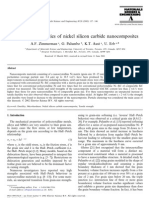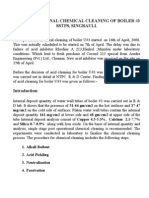0 ratings0% found this document useful (0 votes)
177 viewsMaleable Cast Irons
Maleable Cast Irons
Uploaded by
Gilang Miky Pratama AlwianMalleable cast iron is a heat-treated iron-carbon alloy that solidifies without graphite in the as-cast condition. There are two types - whiteheart and blackheart malleable cast iron - differentiated by their chemical composition and heat treatment process, which determine the resulting microstructure and properties. Malleable cast iron has a combination of nodular graphite and a low-carbon matrix that gives it ductility and toughness, though the nodules are irregular compared to ductile iron. It is used in applications requiring machinability, formability, or impact resistance at low temperatures.
Copyright:
Attribution Non-Commercial (BY-NC)
Available Formats
Download as PDF, TXT or read online from Scribd
Maleable Cast Irons
Maleable Cast Irons
Uploaded by
Gilang Miky Pratama Alwian0 ratings0% found this document useful (0 votes)
177 views0 pagesMalleable cast iron is a heat-treated iron-carbon alloy that solidifies without graphite in the as-cast condition. There are two types - whiteheart and blackheart malleable cast iron - differentiated by their chemical composition and heat treatment process, which determine the resulting microstructure and properties. Malleable cast iron has a combination of nodular graphite and a low-carbon matrix that gives it ductility and toughness, though the nodules are irregular compared to ductile iron. It is used in applications requiring machinability, formability, or impact resistance at low temperatures.
Copyright
© Attribution Non-Commercial (BY-NC)
Available Formats
PDF, TXT or read online from Scribd
Share this document
Did you find this document useful?
Is this content inappropriate?
Malleable cast iron is a heat-treated iron-carbon alloy that solidifies without graphite in the as-cast condition. There are two types - whiteheart and blackheart malleable cast iron - differentiated by their chemical composition and heat treatment process, which determine the resulting microstructure and properties. Malleable cast iron has a combination of nodular graphite and a low-carbon matrix that gives it ductility and toughness, though the nodules are irregular compared to ductile iron. It is used in applications requiring machinability, formability, or impact resistance at low temperatures.
Copyright:
Attribution Non-Commercial (BY-NC)
Available Formats
Download as PDF, TXT or read online from Scribd
Download as pdf or txt
0 ratings0% found this document useful (0 votes)
177 views0 pagesMaleable Cast Irons
Maleable Cast Irons
Uploaded by
Gilang Miky Pratama AlwianMalleable cast iron is a heat-treated iron-carbon alloy that solidifies without graphite in the as-cast condition. There are two types - whiteheart and blackheart malleable cast iron - differentiated by their chemical composition and heat treatment process, which determine the resulting microstructure and properties. Malleable cast iron has a combination of nodular graphite and a low-carbon matrix that gives it ductility and toughness, though the nodules are irregular compared to ductile iron. It is used in applications requiring machinability, formability, or impact resistance at low temperatures.
Copyright:
Attribution Non-Commercial (BY-NC)
Available Formats
Download as PDF, TXT or read online from Scribd
Download as pdf or txt
You are on page 1of 0
Select ed Papers on Met al Cast ing
Arti cl e Transacti ons
Downl oaded by Mohd. Af andi Mut t aqi n
Maleable Cast Irons
Malleable cast iron is a heat-treated iron-carbon alloy, which solidifies in the as-cast condition with a
graphite-free structure, i.e. the total carbon content is present in the cementite form (Fe3C).
Two groups of malleable cast iron are specified, differentiated by chemical composition, temperature and
time cycles of the annealing process, the annealing atmosphere and the properties and microstructure resulting
therefrom.
Whiteheart malleable cast iron
The microstructure of whiteheart malleable cast iron depends on section size. Small sections contain
pearlite and temper carbon in ferritic substrate. In the large sections exists three different zones:
! surface zone which contains pure ferrite,
! intermediate zone which has pearlite, ferrite and temper carbon,
! core zone containing pearlite, temper carbon and ferritic inclusions.
The microstructure shall not contain flake graphite.
Blackheart and pearlitic malleable cast iron
The microstructure of blackheart malleable cast iron has a matrix essentially of ferrite. The microstructure
of pearlitic malleable cast iron has a matrix, according to the grade specified, of pearlite or other transformation
products of austenite.
Graphite is present in the form of temper carbon nodules. The microstructure shall not contain flake
graphite.
Malleable cast iron designation system
The designation according to ISO 5922 (1981) of malleable cast iron consists of one letter designating
the type of iron, two figures designating the tensile strength and two figures designating the minimum
elongation.
a. Letters designating the type of malleable cast iron can be:
o W for whiteheart malleable cast iron,
o B for blackheart malleable cast iron,
o P for peariitic malleable cast iron.
This letter is followed by a space.
b. The first two figures designating the minimum tensile strength, in Newtons per square millimetre, of a 12
mm diameter test piece, divided by ten. For example if the minimum tensile strength were 350 N/mm,
the designation would be 35.
c. The next two figures designating the minimum elongation (L
0
= 3d) as a percentage of a 12 mm
diameter test piece. A nought (0) shall be the first figure when the value is less than 10%, for example if
the minimum elongation is 4%, the designation is 04, and if the minimum elongation is 12%, the
designation is 12.
Abstract:
Malleable cast iron is a heat-treated iron-carbon alloy, which solidifies in the as-cast condition with a graphite-free
structure, i.e. the total carbon content is present in the cementite form (Fe3C). Two groups of malleable cast iron are
specified (whiteheart and blackheart malleable cast iron), differentiated by chemical composition, temperature and time
cycles of the annealing process, the annealing atmosphere and the properties and microstructure resulting therefrom.
http://www.key-to-steel.com/articles.htm
Select ed Papers on Met al Cast ing
Arti cl e Transacti ons
Downl oaded by Mohd. Af andi Mut t aqi n
For example: The designation of a whiteheart malleable cast iron having a minimum tensile strength of 400
N/mm and minimum elongation of 5% when measured on a 12 mm diameter test piece, would be W 40-05.
Chemical composition of malleable iron
The chemical composition of malleable iron generally conforms to the ranges given in the Table 1. Small
amounts of chromium (0.01 to 0.03%), boron (0.0020%), copper (! 1.0%), nickel (0.5 to 0.8%), and
molybdenum (0.35 to 0.5%) are also sometimes present.
Table 1. Chemical composition of malleable iron.
Element Composition %
Carbon 2.16-2.90
Silicon 0.90-1.90
Manganese 0.15-1.25
Sulfur 0.02-0.20
Phosphorus 0.02-0.15
Mechanical properties of malleable iron
Malleable iron, like ductile iron, possesses considerable ductility and toughness because of its
combination of nodular graphite and low-carbon metallic matrix. Because of the way in which graphite is formed
in malleable iron, however, the nodules are not truly spherical as they are in ductile iron but are irregularly
shaped aggregates.
Malleable iron and ductile iron are used for some of the applications in which ductility and toughness are
important. In many cases, the choice between malleable and ductile iron is based on economy or availability
rather than on properties. In certain applications, however, malleable iron has a distinct advantage. It is
preferred for thin-section castings:
! for parts that are to be pierced, coined, or cold formed,
! for parts requiring maximum machinability,
! for parts that must retain good impact resistance at low temperatures, and
! for parts requiring wear resistance (martensitic malleable iron only).
Ductile iron has a clear advantage where low solidification shrinkage is needed to avoid hot tears or
where the section is too thick to permit solidification as white iron (Solidification as white iron throughout a
section is essential to the production of malleable iron). Malleable iron castings are produced in section
thicknesses ranging from about 1.5 to 100 mm and in weights from less than 0.03 to 180 kg or more.
The mechanical properties of test pieces of malleable cast iron shall be in accordance with the values
listed below:
Table 2. Mechanical properties of whiteheart malleable cast iron.
Designation
Diameter of
test piece
mm
Tensile
strength
N/mm
0,2% proof
stress
N/mm
Elongation
(L
0
= 3d)
% min
Hardness
HB
W 35-04 9 - 15 340 - 360 - 5 - 3 230
W 38-12 9 - 15 320 - 380 170 - 210 15 - 8 200
W 40-05 9 - 15 360 - 420 200 - 230 8 - 4 220
W 45-07 9 - 15 400 - 480 230 - 280 10 - 4 220
Select ed Papers on Met al Cast ing
Arti cl e Transacti ons
Downl oaded by Mohd. Af andi Mut t aqi n
Table 3. Mechanical properties of blackheart and pearlitic malleable cast iron.
Designation
Diameter of
test piece
mm
Tensile
strength
N/mm
0,2% proof
stress
N/mm
Elongation
(L
0
= 3d)
% min
Hardness
HB
B 30-06 12 - 15 300 - 6 150 max
B 32-12 12 - 15 320 190 12 150 max
B 35-10 12 - 15 350 200 10 150 max
P 45-06 12 - 15 450 270 6 150-200
P 50-05 12 - 15 500 300 5 160-220
P 55-04 12 - 15 550 340 4 180-230
P 60-03 12 - 15 600 390 3 200-250
P 65-02 12 - 15 650 430 2 210-260
P 70-02 12 - 15 700 530 2 240-290
P 80-01 12 - 15 800 600 1 270-310
Melting Practices
Melting can be accomplished by batch cold melting or by duplexing. Cold melting is done in coreless or
channel-type induction furnaces, electric arc furnaces, or cupola furnaces. In duplexing, the iron is melted in a
cupola or electric arc furnace, and the molten metal is transferred to a coreless or channel-type induction
furnace for holding and pouring.
Charge materials (foundry returns, steel scrap, ferroalloys, and, except in cupola melting, carbon) are
carefully selected, and the melting operation is well controlled to produce metal having the desired composition
and properties. Minor corrections in composition and pouring temperature are made in the second stage of
duplex melting, but most of the process control is done in the primary melting furnace.
Molds are produced in green sand, silicate CO
2
bonded sand, or resin bonded sand (shell molds).
Equipment ranges from highly mechanized or automated machines to that required for floor or hand molding
methods, depending on the size and number of castings to be produced. In general, the technology of molding
and pouring malleable iron is similar to that used to produce gray iron. Heat treating is done in high-production
controlled-atmosphere continuous furnaces or batch-type furnaces, again depending on production
requirements.
After solidification and cooling, the metal is in a white iron state, and gates, sprues, and feeders can be
easily removed from the castings by impact. This operation, called spruing, is generally performed manually with
a hammer because the diversity of castings produced in the foundry makes the mechanization or automation of
spruing very difficult. After spruing, the castings proceed to heat treatment, while gates and risers are returned
to the melting department for reprocessing.
You might also like
- TM34 Tilt Up Technical ManualDocument41 pagesTM34 Tilt Up Technical ManualFelipe CantillanoNo ratings yet
- Asme SB-443Document11 pagesAsme SB-443coronado777No ratings yet
- B 171Document7 pagesB 171manuel flores100% (1)
- Din 2393-1Document6 pagesDin 2393-1alextentwentyNo ratings yet
- A434Document3 pagesA434alirioNo ratings yet
- A A 59588BDocument9 pagesA A 59588BHayleyNo ratings yet
- Heat-Treatment of High Carbon Steel Wire - PatentingDocument4 pagesHeat-Treatment of High Carbon Steel Wire - Patentingعزت عبد المنعم100% (1)
- A571 PDFDocument6 pagesA571 PDFMahendra PatilNo ratings yet
- Preparing Tension Test Specimens For Copper Alloy Sand, Permanent Mold, Centrifugal, and Continuous CastingsDocument11 pagesPreparing Tension Test Specimens For Copper Alloy Sand, Permanent Mold, Centrifugal, and Continuous CastingsWeniton OliveiraNo ratings yet
- Iron-Nickel-Cobalt Sealing Alloy: Standard Specification ForDocument7 pagesIron-Nickel-Cobalt Sealing Alloy: Standard Specification ForJurun_BidanshiNo ratings yet
- Sa 106 PDFDocument16 pagesSa 106 PDFRaju SkNo ratings yet
- ASTM A194 - Portland BoltDocument3 pagesASTM A194 - Portland BoltJorge Luis Chino Celis100% (1)
- Voestalpine Heavy Plate TTD DUROSTAT E 10042015Document16 pagesVoestalpine Heavy Plate TTD DUROSTAT E 10042015Ella Byla SaraNo ratings yet
- Copper Alloy: Leaded Gun Metal Cusn5Zn5Pb5-CDocument1 pageCopper Alloy: Leaded Gun Metal Cusn5Zn5Pb5-CPankaj KumbhareNo ratings yet
- Nfa 49 310 Grade Tu 52 B Tubes PDFDocument1 pageNfa 49 310 Grade Tu 52 B Tubes PDFMitul MehtaNo ratings yet
- A 29 - A 29M - 16Document17 pagesA 29 - A 29M - 16Isabel Christina Gonzalez MoralesNo ratings yet
- STAINLESS STEEL 431 / S43100/ 1.4057 SS 431: AvailabilityDocument3 pagesSTAINLESS STEEL 431 / S43100/ 1.4057 SS 431: Availabilitylir mNo ratings yet
- A 487Document6 pagesA 487arockia1977100% (2)
- Asme Section Ii A Sa-179 Sa-179m PDFDocument4 pagesAsme Section Ii A Sa-179 Sa-179m PDFHyunjong MoonNo ratings yet
- JIS G3452 - UpdatedDocument7 pagesJIS G3452 - Updatedngocbinh8x100% (1)
- B455Document3 pagesB455basha100% (1)
- A 744Document5 pagesA 744Carlos JuárezNo ratings yet
- AMS5772Document7 pagesAMS5772Adrian FinichiuNo ratings yet
- European Steel and Alloy Grades: Russian Steels About UsDocument2 pagesEuropean Steel and Alloy Grades: Russian Steels About UsmuathNo ratings yet
- A 1008 - A 1008M - 02 Qtewmdgtmdjfmq - PDFDocument7 pagesA 1008 - A 1008M - 02 Qtewmdgtmdjfmq - PDFTiến Lượng NguyễnNo ratings yet
- 625 Characterization of Microstructures in Inconel 625 Using X-RAY PDFDocument5 pages625 Characterization of Microstructures in Inconel 625 Using X-RAY PDFKara WhiteNo ratings yet
- A270 PDFDocument5 pagesA270 PDFHansSarmientoNo ratings yet
- PRC-2003G Heat Treating Nickel AlloysDocument9 pagesPRC-2003G Heat Treating Nickel AlloysHenryNo ratings yet
- F3 PDFDocument3 pagesF3 PDFdgkmurtiNo ratings yet
- 13-8 MoDocument2 pages13-8 MofedaquiNo ratings yet
- Astm para La PulvimetalurgiaDocument5 pagesAstm para La PulvimetalurgiaYúber Ramiro Apaza RamírezNo ratings yet
- 219-Asme-Sec-Ii-B-Sb-211 Alu AlloyDocument14 pages219-Asme-Sec-Ii-B-Sb-211 Alu AlloyGRIPHOLD Engineering ServicesNo ratings yet
- Astm B111Document9 pagesAstm B111mmlingNo ratings yet
- Astm A31 (1995)Document4 pagesAstm A31 (1995)gsb2100% (1)
- ASTM B111 - Standard Specification For Copper and Copper-Alloy Seamless Condenser Tubes and Ferrule StockDocument18 pagesASTM B111 - Standard Specification For Copper and Copper-Alloy Seamless Condenser Tubes and Ferrule Stockfininho555No ratings yet
- Astm A 143 - 03Document3 pagesAstm A 143 - 03Glenys MuñozNo ratings yet
- ASTM A213-A213M-05cDocument12 pagesASTM A213-A213M-05cNadhiraNo ratings yet
- Data SheetDocument1 pageData SheetCarlos Mario Beltrán Pérez0% (1)
- SB - 622 PDFDocument10 pagesSB - 622 PDFSamir ChaudharyNo ratings yet
- Sa 29 PDFDocument26 pagesSa 29 PDFRaju SkNo ratings yet
- ISO 1043-4 (EN) - Feb 98Document6 pagesISO 1043-4 (EN) - Feb 98Fernando NavascuesNo ratings yet
- Nickel Iron Alloy 48/ Nilo 48 (ASTM F30) - Sheets & Plates Suppliers in IndiaDocument3 pagesNickel Iron Alloy 48/ Nilo 48 (ASTM F30) - Sheets & Plates Suppliers in IndiaOZAIRTRADELINKNo ratings yet
- Uns N06625Document1 pageUns N06625robertNo ratings yet
- JI S (Japanes E) Stand Ards For ST EE L Ma TE RI ALSDocument2 pagesJI S (Japanes E) Stand Ards For ST EE L Ma TE RI ALSDamar Wardhana100% (1)
- Brazing Allloy Cusil ABADocument12 pagesBrazing Allloy Cusil ABADheeraj SharmaNo ratings yet
- Aisi 1040 Carbon Steel (Uns g10400)Document3 pagesAisi 1040 Carbon Steel (Uns g10400)anishraobNo ratings yet
- Govpub C13 PDFDocument46 pagesGovpub C13 PDFSanchit GoelNo ratings yet
- Is 7754 1975Document11 pagesIs 7754 1975UditChampaneria100% (1)
- Sae Ams 4342e-2017Document5 pagesSae Ams 4342e-2017Hani YilmazNo ratings yet
- Phosphorus Segregation in CR - Mo - V Cast Steel After Regenerative Heat TreatmentDocument6 pagesPhosphorus Segregation in CR - Mo - V Cast Steel After Regenerative Heat Treatmentsanketpavi21No ratings yet
- 2872Document24 pages2872Kaushik SenguptaNo ratings yet
- Astm A48Document6 pagesAstm A48Santiago RamosNo ratings yet
- Din 1.4003Document2 pagesDin 1.4003Dhaniel100% (1)
- AMS4930LDocument8 pagesAMS4930Lremaja1249No ratings yet
- Stainless Steels: Types 321, 347 and 348Document9 pagesStainless Steels: Types 321, 347 and 348Lei WuNo ratings yet
- The Working of Steel: Annealing, Heat Treating and Hardening of Carbon and Alloy SteelFrom EverandThe Working of Steel: Annealing, Heat Treating and Hardening of Carbon and Alloy SteelNo ratings yet
- Chapter 2 Cast IronDocument9 pagesChapter 2 Cast IronHelen AdugnaNo ratings yet
- Thermit Welding of Chromium Vanadium RailsteelDocument8 pagesThermit Welding of Chromium Vanadium Railsteelsantu_23No ratings yet
- Course Prepared by M.Jayaprasad Materials, Manufacturing and Testing of EngineDocument63 pagesCourse Prepared by M.Jayaprasad Materials, Manufacturing and Testing of EngineGopi GopinathNo ratings yet
- Unit - Iii: Ferrous and Non Ferrous MetalsDocument101 pagesUnit - Iii: Ferrous and Non Ferrous Metalssenthilkumar tsNo ratings yet
- Maraging Steel - WikipediaDocument5 pagesMaraging Steel - WikipediaVysakh VasudevanNo ratings yet
- En8 PDFDocument3 pagesEn8 PDFBaskarBossYuvanRomeo'zNo ratings yet
- Lab BiochemDocument14 pagesLab BiochemHyacinth Damolo88% (8)
- CH 18Document7 pagesCH 18Jean MatosNo ratings yet
- An Effective Matrix Diversion Technique For Carbonate FormationsDocument6 pagesAn Effective Matrix Diversion Technique For Carbonate Formationsabbas1368No ratings yet
- SGE127 Emerson General Product Catalogue 2017 en 1Document325 pagesSGE127 Emerson General Product Catalogue 2017 en 1Anonymous 9xvU1FNo ratings yet
- Iso TR 00945-3-2016Document50 pagesIso TR 00945-3-2016SEDEF IMPEXNo ratings yet
- Gross Beta Determination Using A Scintillating Fiber Array Detector For Drinking WaterDocument9 pagesGross Beta Determination Using A Scintillating Fiber Array Detector For Drinking WaterPataki SandorNo ratings yet
- RM 13054252Document2 pagesRM 13054252cihanNo ratings yet
- XiGo Note 101 Powder Surface Area Comparison BET and Acorn AreaDocument4 pagesXiGo Note 101 Powder Surface Area Comparison BET and Acorn Areaprakush01975225403No ratings yet
- IOHEXOLDocument5 pagesIOHEXOLArtem KulikovNo ratings yet
- K.Mohammed RafiDocument3 pagesK.Mohammed RafiAnonymous AkH3e7LNo ratings yet
- Diamonds ManualDocument54 pagesDiamonds ManualluvfitNo ratings yet
- Module DescriptionDocument24 pagesModule DescriptionWoo WeishanNo ratings yet
- Engineering With Ni Steel For LNG ApplicationsDocument2 pagesEngineering With Ni Steel For LNG ApplicationsSathishkumarmuruganNo ratings yet
- Nelson Chemistry 12 TOCDocument7 pagesNelson Chemistry 12 TOCVictorNo ratings yet
- Msds Sigma Ecofleet 530 (Ecol Ha)Document8 pagesMsds Sigma Ecofleet 530 (Ecol Ha)kumarNo ratings yet
- 21 L0 Is 2101 Piping Material Specification 06 9Document1 page21 L0 Is 2101 Piping Material Specification 06 9karthiNo ratings yet
- The Analyses of Variable Refrigerant: Flow and Exergy in An Air Conditioning UnitDocument31 pagesThe Analyses of Variable Refrigerant: Flow and Exergy in An Air Conditioning UnitHackersReunionNo ratings yet
- Maintenance and Preservation of Microbial Cultures PDFDocument16 pagesMaintenance and Preservation of Microbial Cultures PDFyogesh kumar100% (1)
- Reusabilidad de Componentes de TransmisionDocument37 pagesReusabilidad de Componentes de TransmisionhernanNo ratings yet
- Mechanical Properties of Nickel Silicon Carbide NanocomposiDocument10 pagesMechanical Properties of Nickel Silicon Carbide NanocomposimomenziNo ratings yet
- Technical Specifications For DM Plant - Kothagudem TpsDocument633 pagesTechnical Specifications For DM Plant - Kothagudem TpsKrischaEverNo ratings yet
- IEEE STD 563-1978 IEEE STD 664-1993: IEEE Guide On Conductor Self-Damping Measurements"Document12 pagesIEEE STD 563-1978 IEEE STD 664-1993: IEEE Guide On Conductor Self-Damping Measurements"fixer_007722No ratings yet
- Welding Procedure Specification For GTAWDocument9 pagesWelding Procedure Specification For GTAWraja reyhanNo ratings yet
- Le Chatelier - S PrincipleDocument7 pagesLe Chatelier - S Principlenguyen2ahoa7008No ratings yet
- Benchmarks PDFDocument1,738 pagesBenchmarks PDFPiseth Heng100% (1)
- Biomentors Classes Online, MumbaiDocument3 pagesBiomentors Classes Online, MumbaiSmit PatelNo ratings yet
- Professional Reference Shelf: Sothermal Eactor EsignDocument5 pagesProfessional Reference Shelf: Sothermal Eactor EsignSourodip GhoshdastidarNo ratings yet
- Report On Acid CleaningDocument30 pagesReport On Acid CleaningAshutosh SachanNo ratings yet




